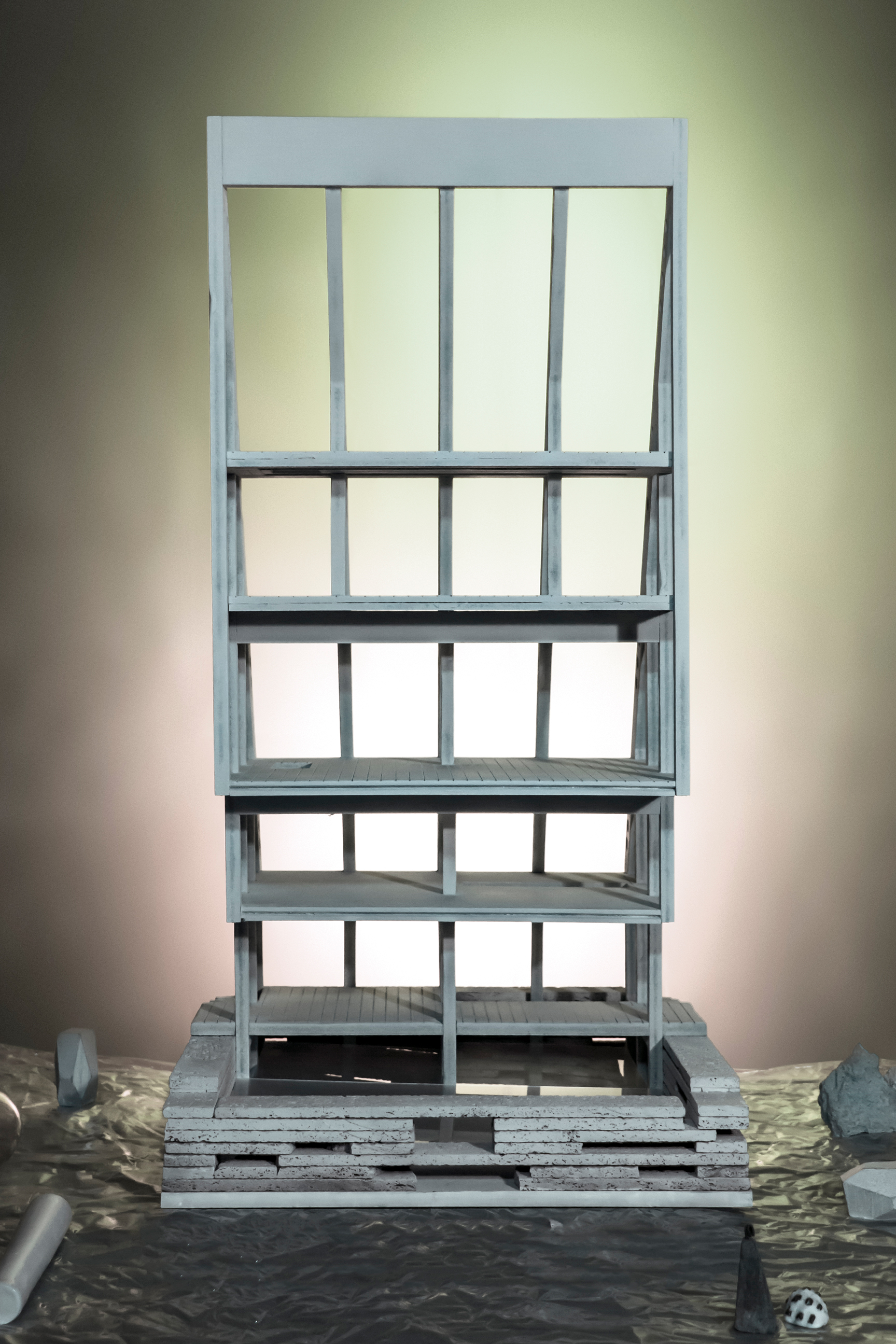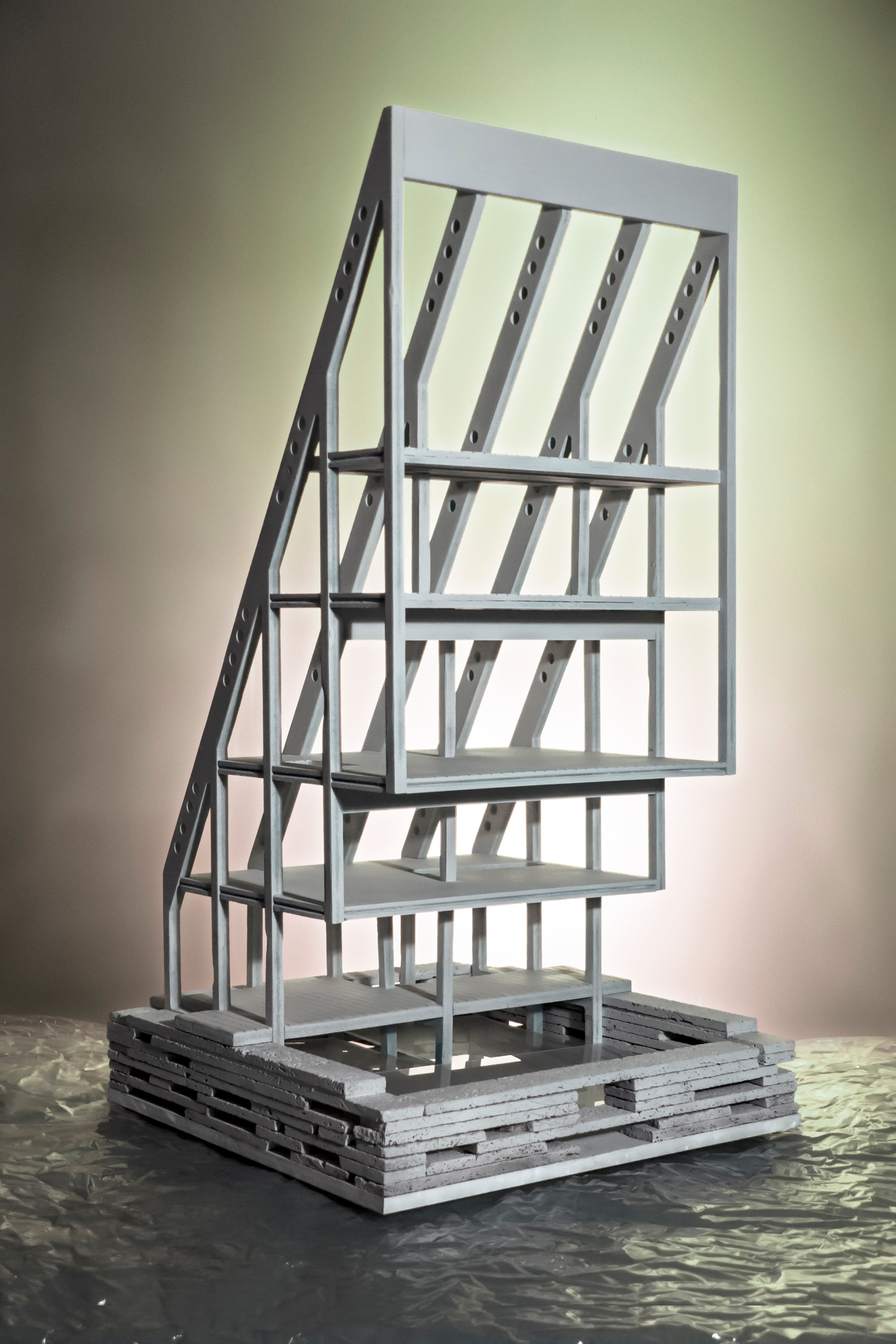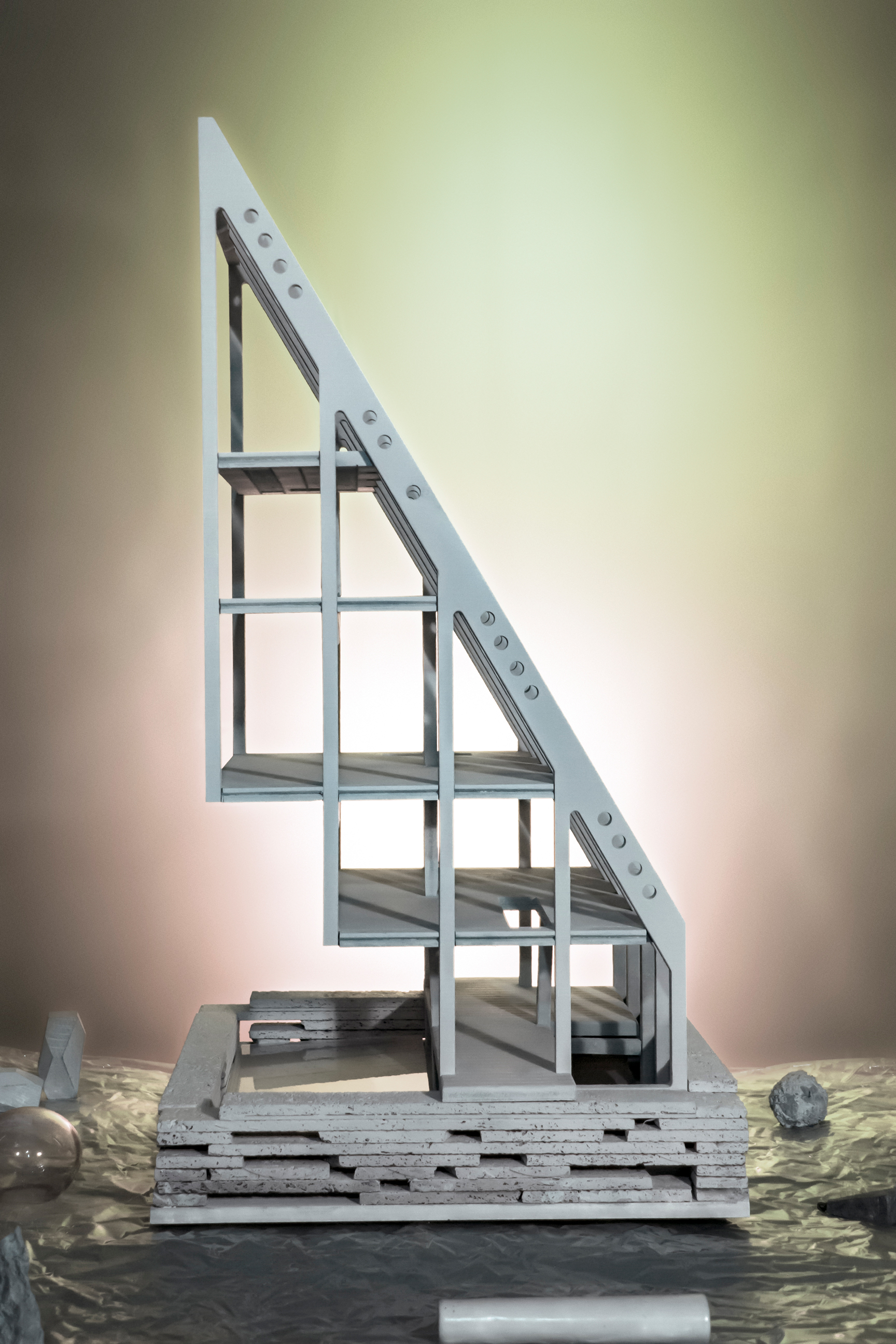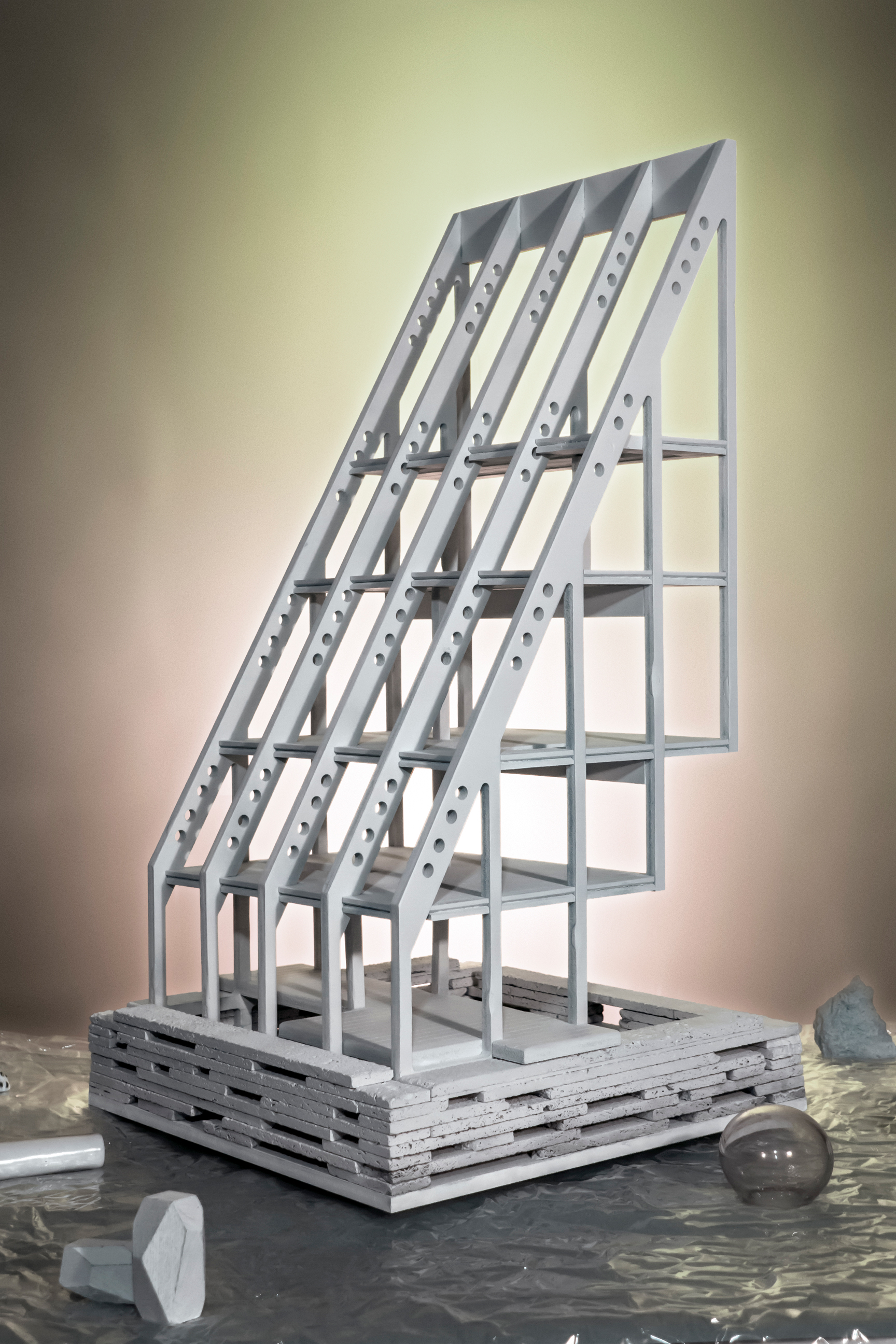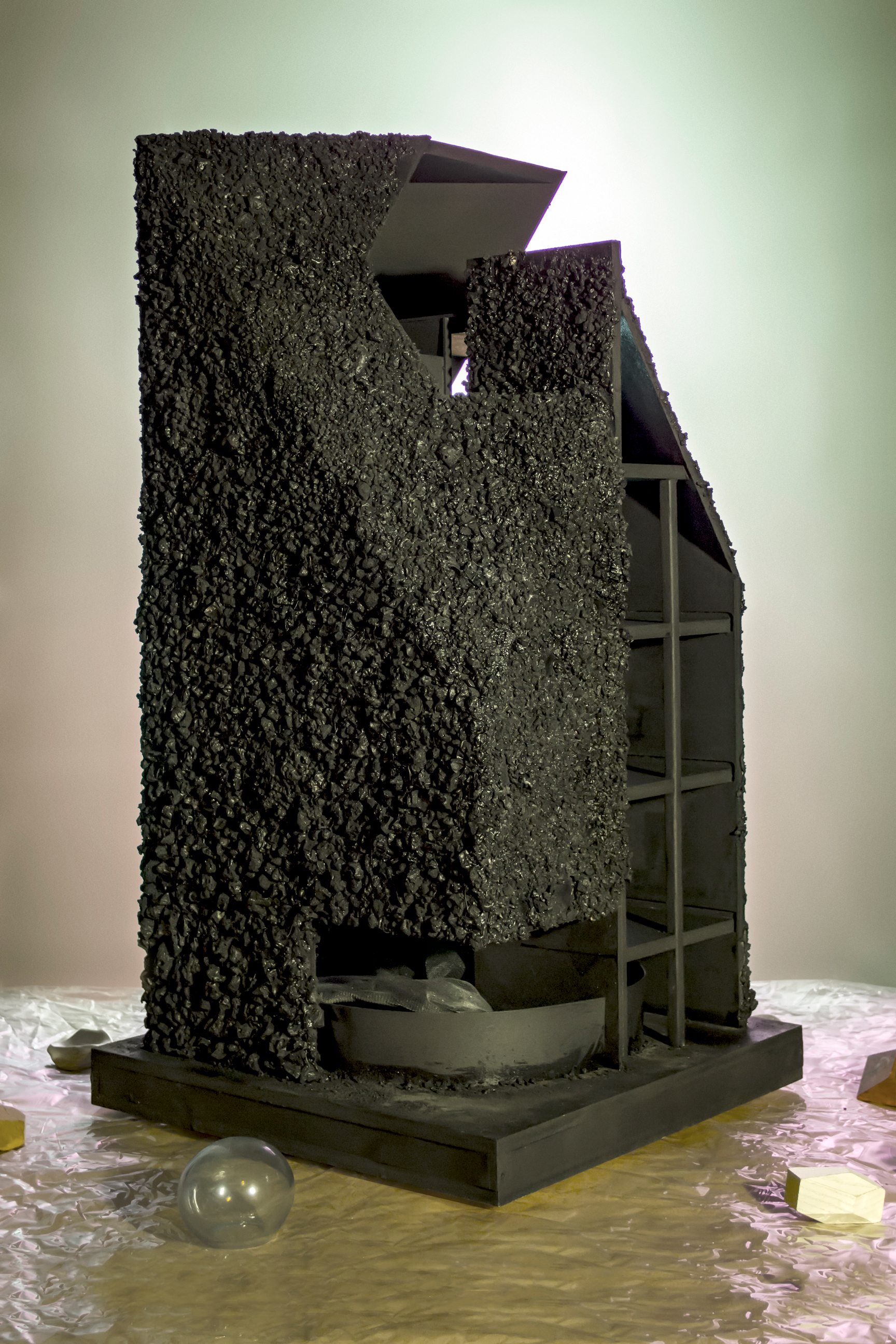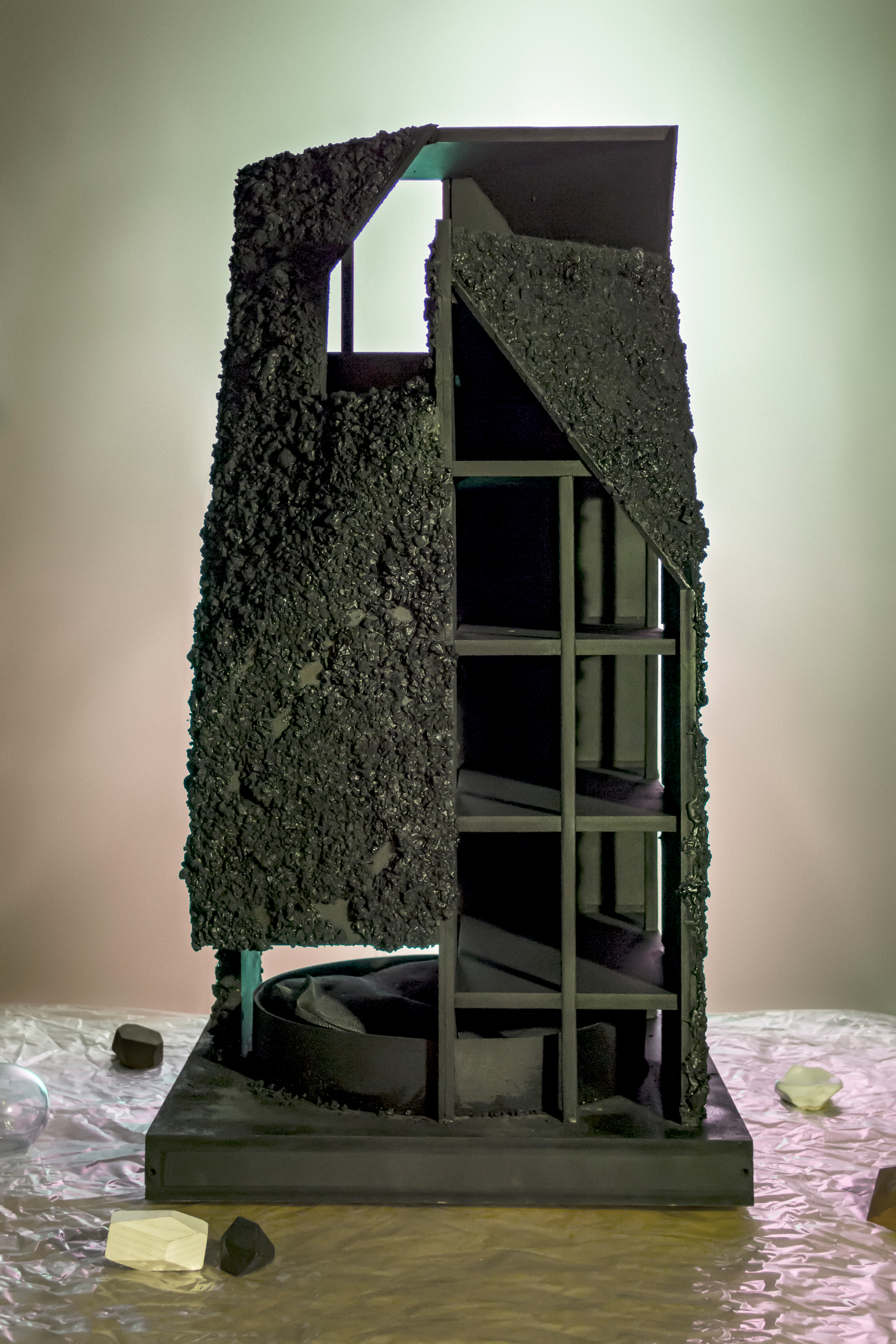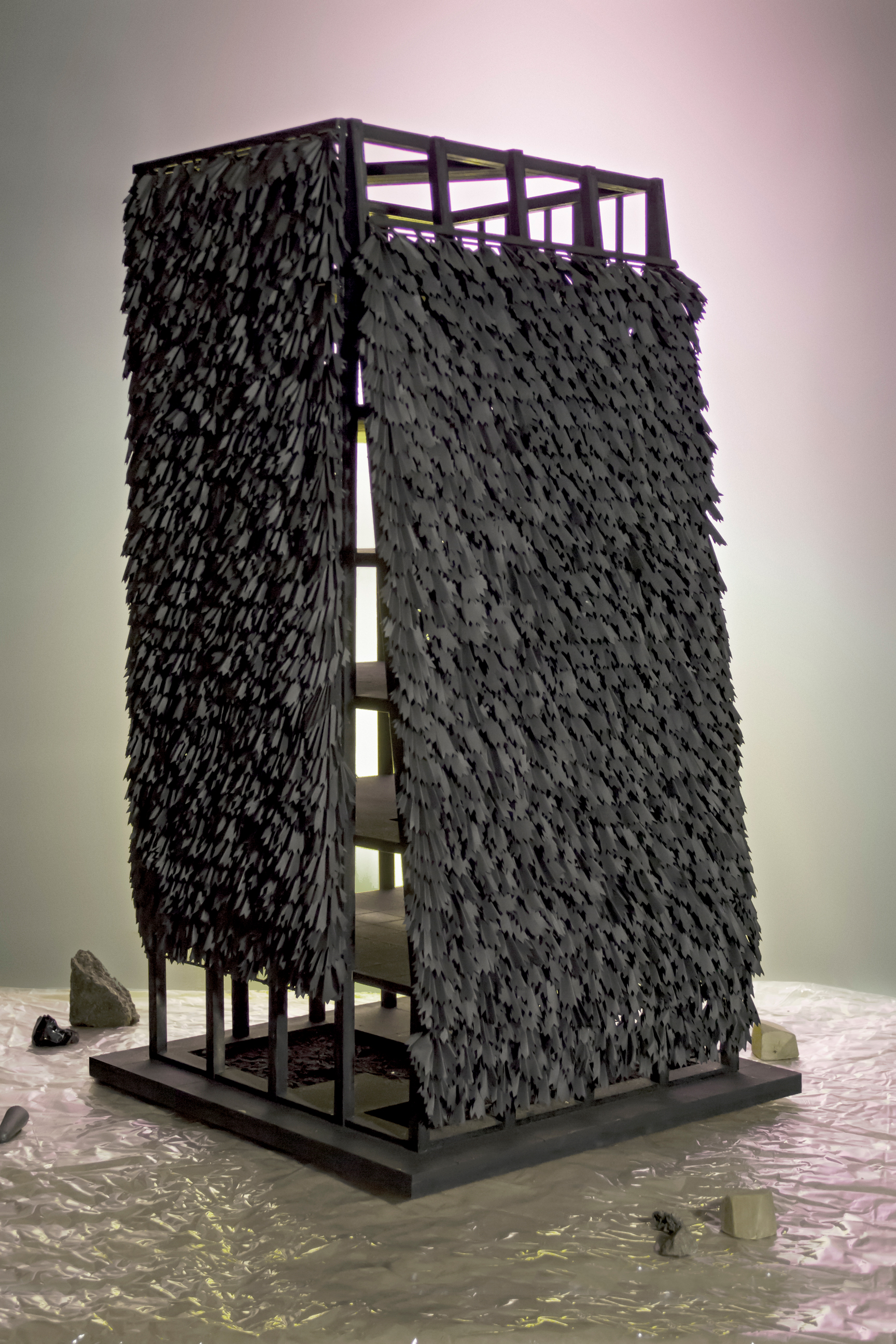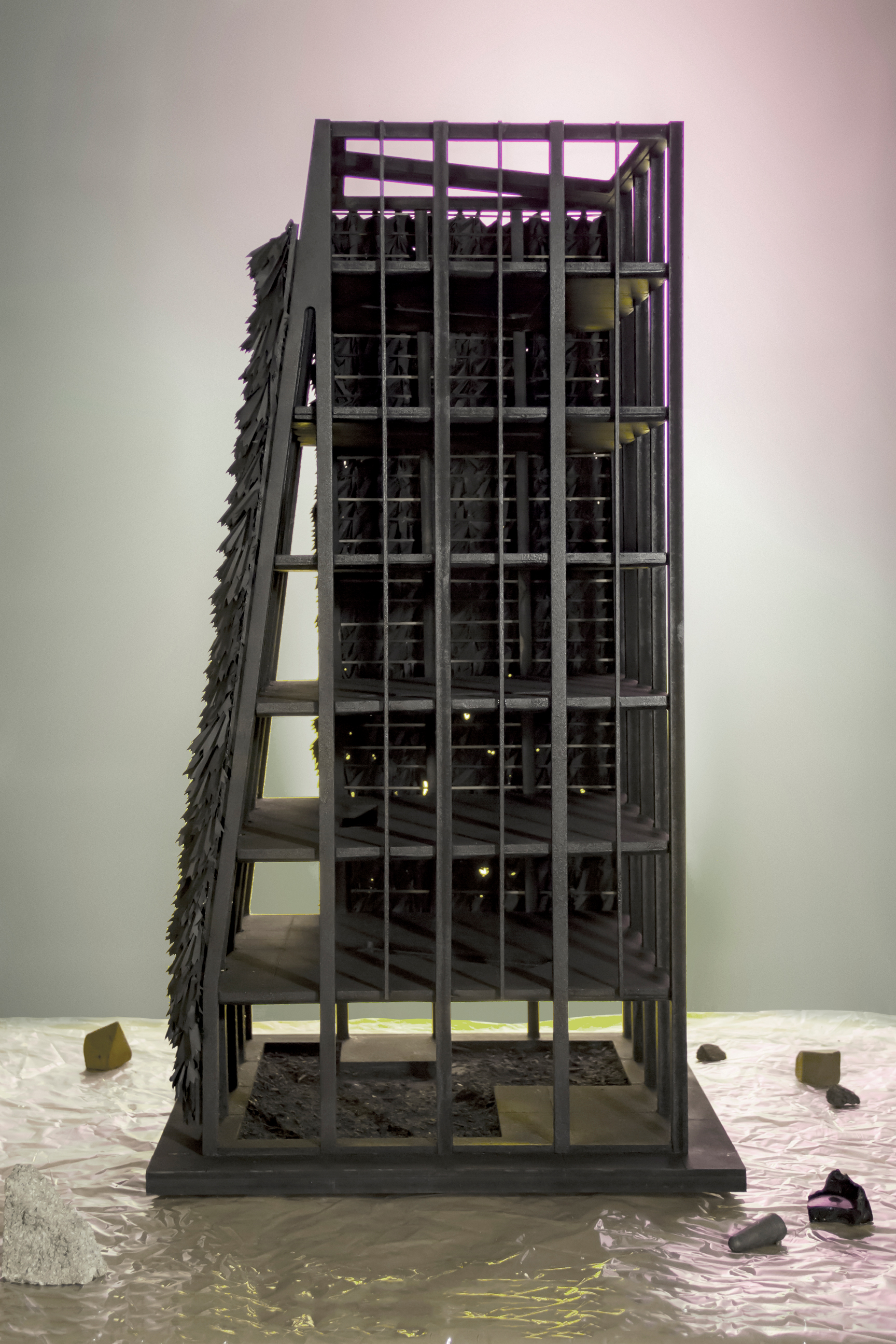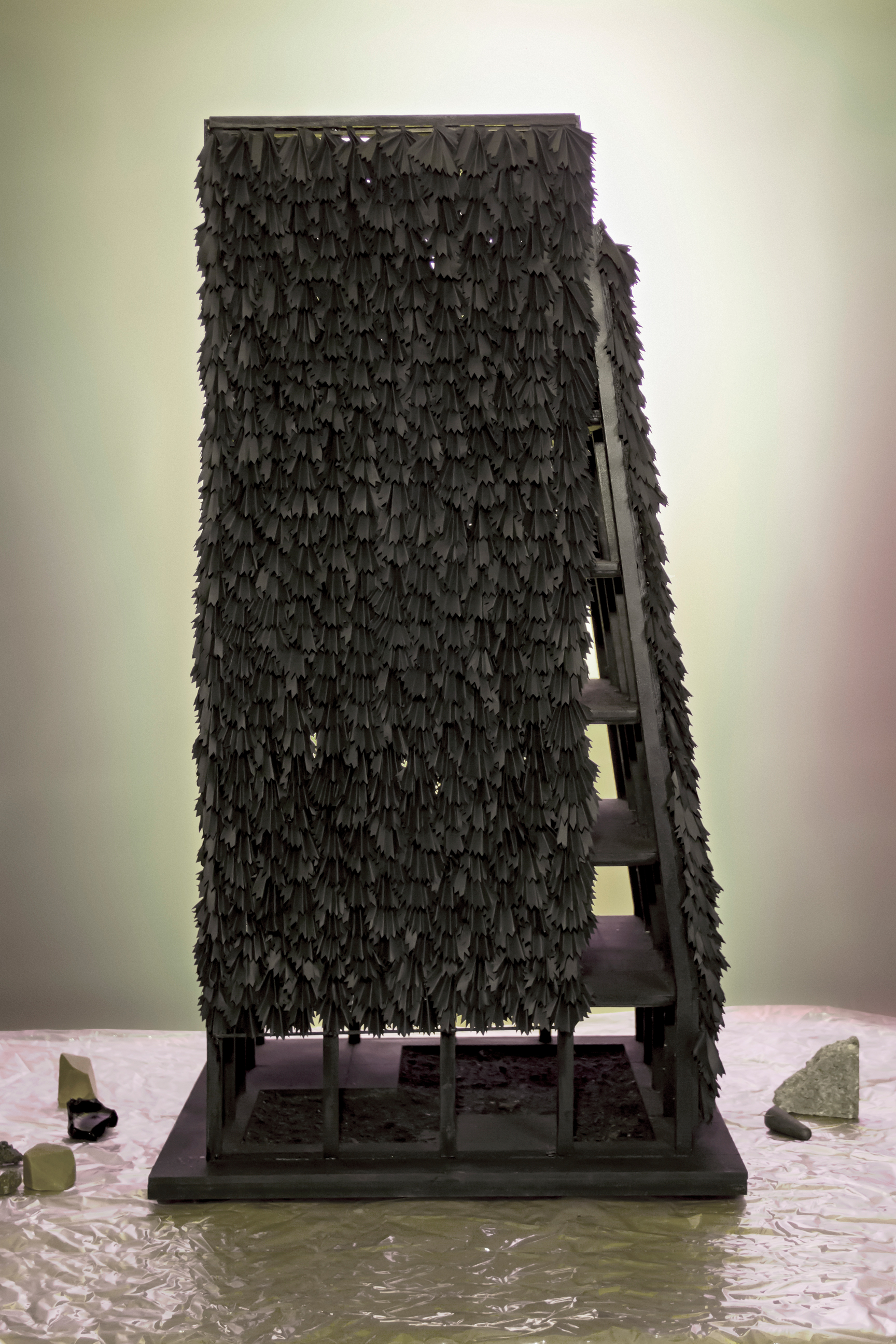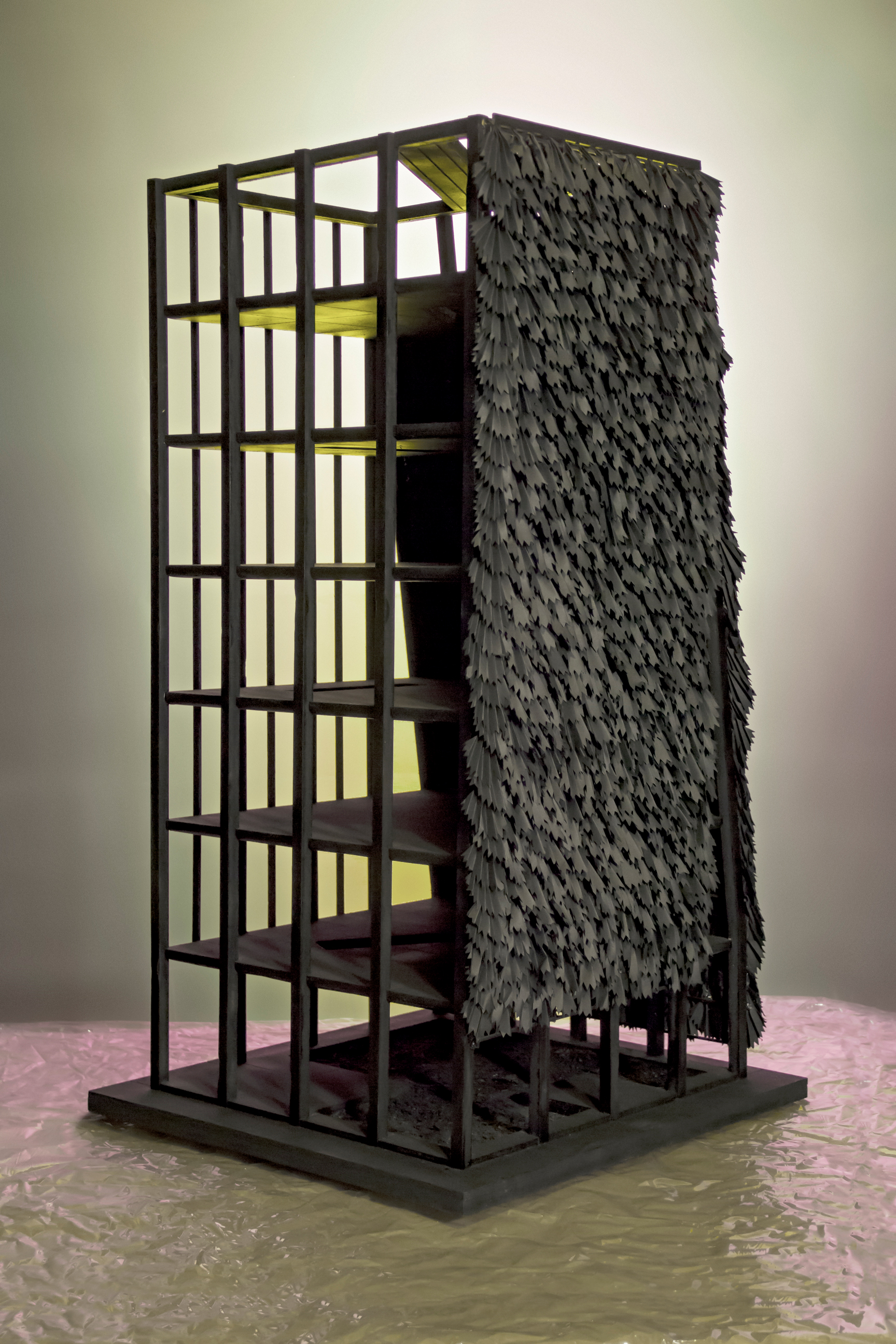Three Houses
Sculpture
Contact Hawai‘i, Honolulu Museum Of Art
O'ahu, Hawai'i
April 1, 2017 - April 16, 2017
Curator: Paradise Cove with Pu‘uhonua Society
Material: wood, paper, coral, basalt
Dimensions: 20" W x 20" L x 39” H
This sculpture, Three Houses, presents a unique approach to showcasing the potential of regenerative Native materials in a more domestic setting of the built environment. The artwork appropriates the concept of an architectural model to display the artist's vision of how buildings 1000 years in the future will have evolved to be more place-based and materially adapted actors in the larger ecosystem of the island itself. As such, Three Houses presents one structure for each tropical setting mountain to sea from forest, to field, to reef demonstrating a concept of the future built environemnts in Hawaii as built from regenerative landscapes for cultivation. Drawing on their adjacent works, Sixteen Cube Truss and Thatch Assembly with Rocks, Connelly transforms the sculptures into artistic mockups of viable building prototypes envisioned specifically for O‘ahu. The work envisions a future place-based built environment that is not just an object, but a proposal for Indigenous futures supporting the use of regenerative materials. Cordage, loulu palm, thatching, rock, bone, and moss emphasizes the importance of considering indigenous building practices and the natural resources available.

PROJECT ANNOTATIONS
As shelter pervades every aspect of mind, society, and environment, notions of the House are subject to divergent demands. The associated and embedded conflicts emerging amongst these various demands, with reference to consumption, capacity, culture, and cost, are resolved only within the event of The House itself. Rejecting the vanguard and over-engineered, over-mediated future, Three Houses responds to the more tacit and palpable interactions of human beings dwelling on volcanic islands a thousand years from now. The challenge of this Hawai‘i-specific installation is to de-design The House with hyper-specificity across three archetype sites: forest, plain, and reef. Each surface, form, cycle, and gradient links ecologies of house, and site is coupled with some range of precise interaction of material, elevation, soil type, solar radiation, rainfall, wind, or global position, as well as a formative effect and delight. The acoustic, haptic, psychic, phantasmic, atmospheric, cognitive, and virtual experiences of site and scale are considered. Three Houses promotes kauhale [a group of houses that comprise the Hawaiian home], as a principle means of production. Dwelling becomes landscape and thus an infrastructure of cultivation, knowledge, program, and culture.
“That's why our houses are sacred... We paint the outside
with pigments containing ancestral bones.
—After Land became scarce, houses became everything.”
“Not the paradise of endless beaches!
—Sand was actually a finite resource. Once, tons of it wa shipped here to build beaches for continentals.”
The Greek origin of the English words for ecology and economy is oikos (eco), or house. The installation expands from the artist's ongoing research presented at www.Hawaii-Futures.com to provide an architectural extrapolation that will echo and amplify the primary role of dwellings in the future recovery of ahupua'a. Each model will be constructed in a way to distinguish the variety of materials used to hypothetically build the house. These are selected carefully and strategically to foreshadow impressions that are both skeptical yet real. The considered provisions will span a full range of categories typical of any serious materials library. These include: Biocomposites, such as biologically derived composites of polymers and fibers containing organic or inorganic compounds sourced from living organisms or biochemical processes of plants, animals, and fungi; Polymers, such as synthetic or semi-synthetic thermoplastics, thermoset, or elastomer; Metals, such as those that are ferrous (based on iron) and non-ferrous; Minerals, such as inorganic crystalline solids and chemical compounds that are either geogenic or anthropogenic; and Ceramics, such as those that are clay-based, cementitious, or glass. Selected materials will also be evaluated through aspects of embodied energy, thermodynamics, fluid mechanics, life cycle, and cost.
A preliminary list of Hawai‘i materials that fall within these categories for inclusion in Three Houses may include: Albizia, Alloy, Bamboo, Bone, Coqui Frog Skin, Cut Concrete, Feathers, Hair, Hala, In Vitro Coral, Modified Koa, Modified 'Ohi'a, Moss, Mucus, Obsidian / Glass, Oil / Pigment, Palm Was, Paper, Pili, Recycled Plastic, Refurbished Steel, Sap / Slime, Seaweed / Seagrass, Strawberry Guava, Teeth, Volcanic Rock, Vines, and Wire.
Surfaces will showcase adaptations that advance beyond existing medieval and heliocentric notions of design. In addition to Sun, Three Houses will also be designed for habits of wind, water catchment, and moonlight. Public and private space will become another way to consider Night. A surface may tilt to catch moonlight ceremoniously, or bow into aerodynamic flow. Such functions and intentions of surfaces will enable the house to become a favorable object on the site. Form, cycle, and gradient are the driving forces of ecological design. As each house becomes system, its overall composition will engage some level of commentary (by inclusion or exclusion) based on elevation, soil type, solar radiation, rainfall, wind, or direction. Formative affect and delight are enhanced in the acoustic, haptic,psychic, phantasmic, atmospheric, cognitive, and virtual experience of life in each house-site. Forest dwellings may be taller with increased surface area and canopy to capture and retain moisture. Plain dwellings may be flatter with potentially subterranean components. Reef dwellings may be raised above reconstructed coral platforms that function as fishponds. Three historic artifacts of infrastructure will mechanically link forest, plain, and reef. This comprises the fourth model display. These artifacts may or may no longer operate at the time of 3017, but are at the least historical, and will support auxiliary narratives of the ahupua‘a recovery that has been integral to each house and site. Intentionally primitive in their presence and application on site, these artifacts will relate to the generation of resources and regulation of climate. The artifacts in consideration currently include: (1) Energy apparatus obtained with wobbling vertical elements; (2) Misting apparatus regulating moisture, temperature, and atmosphere; (3) Porous submersible rock apparatus.
